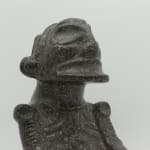Taino Zemi Sculpture, 1200 CE - 1500 CE
Stone
height 23.5 cm
height 9 1/4 in
height 9 1/4 in
LI.3520
Further images
-
(View a larger image of thumbnail 1
)

-
(View a larger image of thumbnail 2
)

-
(View a larger image of thumbnail 3
)

-
(View a larger image of thumbnail 4
)

-
(View a larger image of thumbnail 5
)

-
(View a larger image of thumbnail 6
)

-
(View a larger image of thumbnail 7
)

-
(View a larger image of thumbnail 8
)

-
(View a larger image of thumbnail 9
)

-
(View a larger image of thumbnail 10
)

An exceptional Taio Zemí stone sculpture. Zemís constitute some of the most important and remarkable among the artistic expressions of the Taino culture, they were sculptures intended to represent the...
An exceptional Taio Zemí stone sculpture. Zemís constitute some of the most important and remarkable among the artistic expressions of the Taino culture, they were sculptures intended to represent the physical incarnation of a Taino god, spirit, or ancestor. These sculptures were most probably used for worship and rituals in the two social classes of the Taino society: the naborias and the nitaínos. The naborias were the class tasked with manual labour, and were in charge of fishing, hunting, and working in the fields. The nitaínos constituted the nobility of the Taino society and supervised the work of the naborias. Probably ritual objects were present also in the huts were naborias families resided (though it is probable that ritual objects to be used in houses were made of perishable material such as wood). The beautiful stone objects which survived until this day were probably used by the cacique, the elite of the nitaínos class in charge of government and worship for their centralized magico-religious ritual on a village scale These rituals were most probably aimed at the preservation of the natural and social order of the Taíno civilisation, and invoked divine aid for the growth of crops, fertility, and other key elements of the daily lives of the people.
This particular Zemí sculpture represents a figure crouching. His general proportions are skeletal – his face is reminiscent of a skull, with hollow eyes and nose, and all flesh seemingly absent. The skeletal aspect is reinforced by a dramatic rendition of the scapulae and backbone. The peculiar facial features, such as the circular eyes and broad, open mouths are typical of Taíno figurative sculpture. The figure wears decorated armbands at the pits and wrists, and a decorated band over the head.
The posture of the figure results in an approximately triangular shape, which reminds the viewer of Trigonolitos, the three cornered stones which form one of the most important testimonies of the ritual practices of the Taíno world. They were probably made to represent the mountains of the islands were the Taíno lived, and were used for rituals connected to fertility and to securing good harvests of cassava, a root which constituted the staple food of the diet of Taínos. The closeness to the trigonolito type allows to propose a potential interpretation of this Zemí sculpture as connected to fertility and harvest rituals.
Taino culture flourished in the Caribbean between c.1200-1500. The arrival of the Spanish in 1492 resulted in its rapid decline but the ritual objects left by their civilisation testify to high levels of craftsmanship.
This particular Zemí sculpture represents a figure crouching. His general proportions are skeletal – his face is reminiscent of a skull, with hollow eyes and nose, and all flesh seemingly absent. The skeletal aspect is reinforced by a dramatic rendition of the scapulae and backbone. The peculiar facial features, such as the circular eyes and broad, open mouths are typical of Taíno figurative sculpture. The figure wears decorated armbands at the pits and wrists, and a decorated band over the head.
The posture of the figure results in an approximately triangular shape, which reminds the viewer of Trigonolitos, the three cornered stones which form one of the most important testimonies of the ritual practices of the Taíno world. They were probably made to represent the mountains of the islands were the Taíno lived, and were used for rituals connected to fertility and to securing good harvests of cassava, a root which constituted the staple food of the diet of Taínos. The closeness to the trigonolito type allows to propose a potential interpretation of this Zemí sculpture as connected to fertility and harvest rituals.
Taino culture flourished in the Caribbean between c.1200-1500. The arrival of the Spanish in 1492 resulted in its rapid decline but the ritual objects left by their civilisation testify to high levels of craftsmanship.









